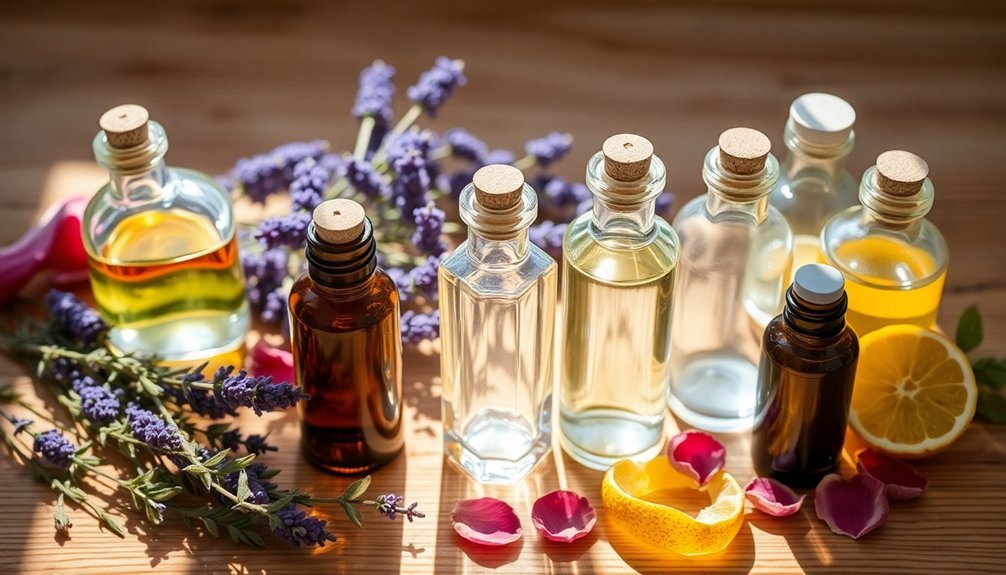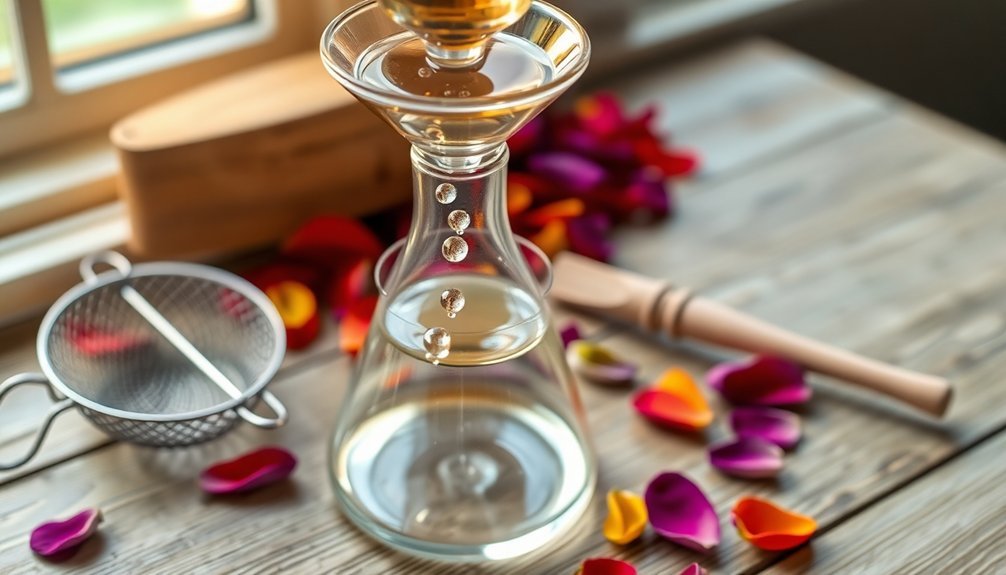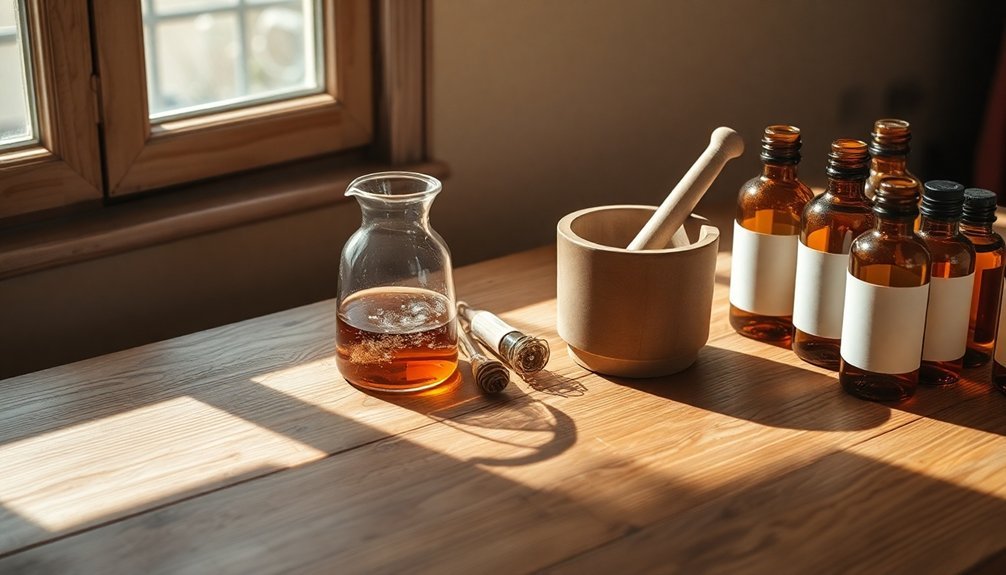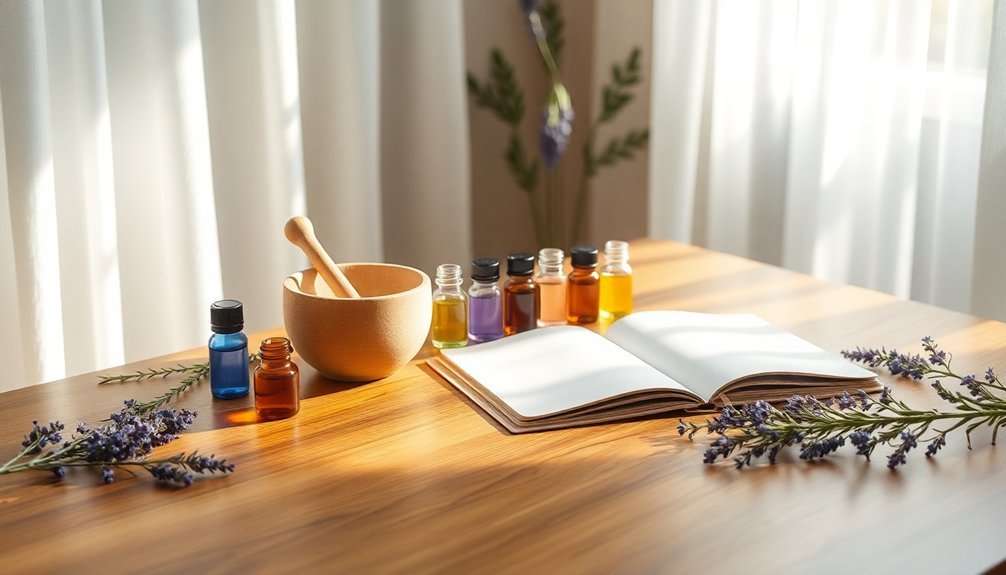You'll need several basic tools to start making natural perfumes at home. Essential items include dark glass bottles for storage, precise measuring tools like digital scales and droppers, and mixing equipment such as glass beakers and wooden stirring rods. Don't forget safety gear – nitrile gloves and protective eyewear are must-haves. You'll also want proper documentation materials and basic filtering tools like cheesecloth. The journey into perfume-making holds many more fascinating details to discover.
Essential Glass Containers and Bottles

Three key qualities make glass containers essential for creating natural perfumes at home: their protective properties, chemical stability, and aesthetic appeal.
When you're selecting containers, opt for dark or UV glass bottles that shield your fragrances from harmful light and heat. Unlike plastic, glass won't react with your essential oils, guaranteeing your perfume maintains its original scent. Amber or cobalt glass bottles provide maximum protection for your essential oil-based perfumes.
You'll find various glass container options to suit your needs. For everyday use, choose fine mist spray bottles with gold or silver nozzles. If you prefer direct skin application, roll-on bottles work perfectly. For gift-giving or travel, 10mL bottles are ideal.
Whatever style you select, make sure your containers have airtight caps and are free from defects. Remember to clean and sanitize them thoroughly before use to preserve your perfume's quality.
Measuring Tools for Precise Blending
Four essential measuring tools form the foundation of precise perfume blending: digital scales, measuring cups and spoons, graduated cylinders, and droppers.
You'll need a digital scale that measures down to 0.01g for professional results, ideally with a capacity of at least 100g. Stainless steel measuring cups and spoons are crucial for creating consistent dilutions, while borosilicate beakers offer lightweight alternatives for 50ml measurements.
For liquid measurements, you'll find graduated cylinders indispensable, especially when working with essential oils and absolutes. They work perfectly alongside droppers and pipettes, which you'll use to transfer small amounts of materials. A specialized Monprene dropper helps prevent evaporation during the measurement process.
While you can choose between glass or plastic droppers, glass options prove more durable and reusable in the long run. For convenience, disposable pipettes offer an economical alternative to glass ones.
Mixing and Stirring Equipment

You'll find glass droppers and pipettes essential for precise measurements when creating natural perfumes, as they allow you to add small amounts of concentrated oils with perfect control.
Wooden stirring rods are your go-to tools for gentle yet thorough blending, preventing any unwanted reactions that metal tools might cause with delicate essential oils. A reliable magnestir device provides consistent and hands-free mixing to ensure oils and alcohol blend thoroughly.
Your choice of mixing bowl material matters greatly – while glass and stainless steel bowls are ideal for most applications, you'll want to avoid plastic containers as they can react with and absorb essential oils.
Glass Droppers And Pipettes
Precise measurement lies at the heart of natural perfumery, making glass droppers and pipettes essential tools for your perfume-making journey.
While glass droppers can be environmentally friendly, plastic pipettes offer better precision and hygiene for home perfumery. You'll want to choose based on your specific needs and frequency of use.
For best results when working with these tools:
- Always use separate droppers or pipettes for different perfumes to prevent cross-contamination
- Opt for disposable plastic pipettes when experimenting with new formulas
- Keep your workspace clean and free from environmental contaminants like dust or pet hair
Remember that weighing ingredients is more accurate than counting drops.
If you're using glass droppers, clean them thoroughly after each use. For ideal hygiene and precision, consider investing in a set of disposable plastic pipettes, especially when creating your final perfume blends.
Wooden Stirring Rods
While droppers and pipettes handle the careful measurements, proper mixing equipment takes your natural perfumery to the next level.
When working with natural perfumes, you'll find that wooden stirring rods offer a gentle alternative to magnetic stirrers. They're particularly useful for manual blending of essential oils with carrier oils and creating layered fragrances.
For projects that don't require continuous stirring, wooden rods give you direct control over the mixing process. You can adjust your stirring pressure and speed based on the ingredients you're working with.
While magnetic stirrers excel at long-term tincturing processes like ambergris preparation, wooden rods are ideal for quick blending sessions and allow you to feel the consistency of your mixture.
They're also perfect for smaller batches where you need precise control over the blending process.
Mixing Bowl Materials
Selecting the right mixing bowl material plays an essential role in natural perfumery. You'll find that certain materials work better than others when creating your fragrances.
Glass bowls are your safest choice since they don't react with essential oils or other ingredients, making them perfect for melting wax and mixing components.
When choosing your mixing bowls, consider these key options:
- Glass bowls – Non-reactive and ideal for melting ingredients
- Ceramic bowls – Great for working with beeswax and perfume blends
- Stainless steel bowls – Durable and easy to clean for general mixing
You'll want to avoid porous materials that might absorb scents and compromise your fragrances.
Remember that heat-resistant properties are important if you're planning to melt ingredients using a stove or microwave.
Storage and Organization Systems

Proper storage of your natural perfumes plays an essential role in maintaining their quality and extending their lifespan.
You'll want to keep your creations in a cool, dry place away from direct sunlight and bathroom humidity. A dedicated drawer, cabinet, or shaded shelf works best.
To stay organized, sort your perfumes by fragrance family or intended use. Consider using decorative trays or tiered acrylic organizers to display and protect your bottles.
For larger collections, a rotating lazy Susan or compartmentalized cabinet can help maximize space while keeping everything accessible.
Don't forget to store your perfumes in dark glass bottles to shield them from light damage.
Track purchase dates and monitor your perfumes for any changes in color or scent. Label all containers clearly, especially when working with samples or small batches.
Safety Gear and Protection
When making natural perfumes, you'll need essential safety gear like nitrile gloves, a vapor-protective mask, and safety goggles to protect yourself from potential hazards.
Your workspace must be well-ventilated and kept away from heat sources to prevent the buildup of harmful fumes.
To handle materials safely, you should test essential oils for allergic reactions, maintain proper dilution ratios, and keep a first aid kit with eye wash readily available.
Essential Safety Equipment Needed
Safe natural perfume making requires several essential pieces of protective equipment.
You'll need proper protective gear to handle concentrated essential oils and other fragrant materials safely. Choose a lab coat or protective garment to shield your clothing, and always wear nitrile gloves that are specifically rated for chemical resistance.
Make sure you're working in a well-ventilated space and have these key safety items on hand:
- Safety goggles with anti-fog coating to protect your eyes from accidental splashes
- An eye wash station and first aid kit within easy reach
- A chemical-resistant apron to guard against spills and stains
Store all safety equipment properly when not in use, and regularly inspect your gear for wear or damage.
Replace gloves immediately if they become contaminated or show signs of deterioration.
Proper Handling Precautions
Three critical handling precautions guarantee your safety when working with essential oils for natural perfumes.
First, always perform a patch test by applying a small amount of diluted oil to your skin and monitoring for reactions over 48 hours. This step is especially important if you're sensitive to common allergens like linalool.
Second, properly dilute your oils using carrier agents like perfumer's alcohol or fractionated coconut oil at a ratio of 20% fragrance to 80% carrier. Never use water as a diluting agent since it won't mix with oils.
Third, store your essential oils correctly in dark glass bottles with screw caps, keeping them in a cool, dark place.
Remove rubber droppers to prevent degradation, and always keep oils away from children and pets to avoid accidental exposure or chemical burns.
Workspace Protection Guidelines
To maintain a safe environment while creating natural perfumes, you'll need proper safety gear and workspace protection measures.
Start by ensuring your workspace has good ventilation – open windows or use ventilation systems to prevent the buildup of essential oil vapors.
Your basic protective gear should include:
- A lab coat or apron to protect your clothing and skin from spills
- Safety goggles to shield your eyes from accidental splashes
- Nitrile gloves that offer better chemical resistance than standard rubber gloves
Don't forget about respiratory protection – wear a mask designed to filter organic vapors.
Keep an emergency eye wash station and first aid kit within reach, and make sure you know how to use them.
If you're working with concentrated oils, consider installing an emergency shower nearby for additional safety.
Oil Dispensing Instruments
Precise oil dispensing instruments form the backbone of natural perfume creation at home.
You'll need essential oil droppers, preferably made of glass, to measure your raw oils accurately and prevent cross-contamination between different scents. For your carrier oils, like coconut or jojoba, you'll want dedicated dispensers that help you maintain proper dilution ratios.
When blending multiple oils, pipettes become your best friend. They allow you to transfer tiny amounts with precision, ensuring your recipe stays consistent. Don't forget to clean them thoroughly after each use.
For your final mixing stage, you'll need proper measuring containers, such as glass beakers or bottles with clear volume markings. Make sure they're spotlessly clean and equipped with lids to protect your precious blends from evaporation.
Cleaning and Maintenance Supplies

Maintaining a clean workspace and proper supplies is essential for creating natural perfumes at home. You'll need non-toxic cleaning products, protective equipment, and proper storage solutions to guarantee a safe and efficient perfume-making environment.
Keep these cleaning and maintenance supplies ready:
- Plant-based cleaning solutions and soft cloths for wiping surfaces
- Protective gloves and a first aid kit for safe handling
- Airtight containers and storage bins for organizing ingredients
Be sure to clean your workspace before and after each perfume-making session using mild soap and water.
Store your ingredients in a cool, dry place away from sunlight, and always label containers clearly.
Don't forget to maintain good ventilation and keep a work mat handy to protect your surfaces from spills.
Dispose of waste materials properly, following local recycling guidelines.
Temperature Control Equipment
When creating natural perfumes at home, proper temperature control equipment serves as the foundation for successful extractions and fragrance preservation.
You'll need reliable thermometers to monitor temperatures throughout the process, ensuring you don't damage delicate aroma compounds.
For heating, electric elements offer a safer alternative to steam-based systems. You can control temperatures precisely, typically within ±2°C, which is essential for maintaining fragrance integrity.
To cool your extracts, you'll want an efficient cooling system – this can be as simple as ice for DIY methods or a more sophisticated cooling-water setup for larger operations.
Don't forget about vacuum pumps, which help reduce extraction temperatures and protect those precious aromatic components.
These pumps create low-pressure environments that allow for gentler extraction while preserving the original scents of your plant materials.
Filtering and Straining Tools

You'll need multiple mesh strainers of varying sizes to effectively remove botanical particles from your natural perfume ingredients.
For extra clarity, layer cheesecloth over your strainers or use it independently to catch even the tiniest plant matter during the filtration process.
Coffee filters can serve as an excellent final filtering step, helping you achieve crystal-clear perfume bases that are free from sediment.
Mesh Strainers And Sizes
Proper filtration stands as a critical step in creating natural perfumes, requiring the right mesh strainers to remove unwanted particles and plant material from your fragrances.
When selecting strainers for your perfume-making process, you'll need different mesh sizes to achieve the best results at various stages of filtration.
- Fine mesh strainers (200-400 microns) work best for capturing tiny particles and ensuring your final product is crystal clear.
- Medium mesh strainers (400-800 microns) help with the initial filtering of larger botanical materials and coarse sediments.
- Coarse mesh strainers (800+ microns) are ideal for the first pass of straining, removing larger plant matter and debris.
Choose stainless steel strainers whenever possible, as they're durable and won't react with your essential oils or alcohol-based ingredients.
Cheesecloth Filtering Methods
Beyond metal strainers, cheesecloth and similar fabric materials offer a gentler approach to filtering natural perfumes. You'll want to select unbleached muslin or fiberglass netting that's both flexible and durable. If you're using muslin, soak it in baking soda for 24 hours before your first use.
| Material | Benefits | Best Uses |
|---|---|---|
| Cheesecloth | Highly flexible, disposable | Quick straining |
| Muslin | Durable, reusable | Daily filtering |
| Fiberglass Netting | Strong, heat resistant | Heavy processing |
To set up your filter, lay a square foot of your chosen material inside a clean mason jar with corners hanging out. Add your botanicals, pour just enough water to cover them, and let them soak. When ready, gather the corners, lift, and gently squeeze the contents into a saucepan.
Coffee Filters For Clarity
While coffee filters may seem like a humble tool, they serve as an effective and economical method for achieving crystal-clear perfumes at home.
You'll find that passing your perfume concentrate through multiple filters can markedly improve its clarity, making it an ideal solution for small-scale production.
For best results, chill your concentrate before filtering to help separate waxes and impurities.
Here's what makes coffee filters particularly useful:
- They're readily available and cost-effective compared to specialized equipment
- They effectively remove larger particles from your perfume concentrates
- You can layer multiple filters for enhanced filtration
While coffee filters won't capture the finest particles like professional filtration systems, they're a practical starting point for home perfumery.
If you need finer filtration later, you can upgrade to millipore filters or stainless steel strainers.
Documentation and Labeling Materials

The art of documenting and labeling your natural perfumes requires careful attention to legal requirements and industry standards.
You'll need to include essential information on your labels: clearly identify your product as perfume, specify the liquid volume, provide usage directions, and list any necessary warnings, especially for alcohol-based formulas.
Include your name and contact details as the manufacturer.
List your ingredients in descending order by weight, using common names or INCI nomenclature. While you can list "fragrance" collectively, you must disclose specific allergens.
Place this information prominently on the back or side panel. If your perfume contains alcohol, don't forget to include the flammable symbol.
Quality Testing Equipment
Proper documentation sets the foundation for your perfume creation, and quality testing elevates it to professional standards.
While professional labs use sophisticated equipment like gas chromatography and mass spectrometry, you can start with basic tools for home perfumery.
Essential home testing equipment includes:
- A digital pH meter to check your perfume's acidity and guarantee it's skin-safe
- A simple refractometer to measure the purity and concentration of your essential oils
- A small digital scale for precise measurements of your ingredients
You don't need advanced spectrophotometers or chromatographic analyzers to create quality natural perfumes.
Focus on these basic tools to maintain consistency and safety in your creations.
Remember to regularly calibrate your equipment and store it properly to guarantee accurate readings every time you test.
Aromatherapy Workspace Essentials

Setting up an effective aromatherapy workspace requires four core elements: quality tools, proper storage solutions, safety equipment, and organizational supplies.
You'll need glass beakers, pipettes, and stirring rods for measuring and mixing your ingredients. Store your essential oils in amber glass bottles with eye-droppers, and keep small adhesive labels handy to track your contents.
Don't forget protective gear – gloves, safety glasses, and masks are essential when working with concentrated oils.
Keep your workspace organized with a record book to document your recipes and blends. Use perfume tester strips to evaluate scents, and keep coffee grounds nearby to reset your nose between testing.
An electric diffuser will help maintain a pleasant atmosphere while you work, and spray bottles are useful for creating natural air fresheners.
Frequently Asked Questions
How Long Should I Let My Natural Perfume Blend Mature Before Use?
You should let your natural perfume mature for 4-6 weeks minimum. You'll notice the scent becoming more balanced and harmonious. If you're patient, aging it for 2-3 months can yield even better results.
Can I Use Dried Herbs Instead of Essential Oils?
Yes, you can use dried herbs instead of essential oils. You'll need to infuse them in carrier oil through gentle heating. While the scent may be subtler, it's a natural and cost-effective alternative.
Why Does My Homemade Perfume Smell Different on Different People?
Your perfume smells different on each person because everyone's unique body chemistry, skin type, and natural oils interact differently with the fragrance. Your diet, hormones, and even daily activities affect how it develops.
How Can I Make My Natural Perfume Scent Last Longer?
You'll get longer-lasting natural perfume by using higher concentrations of essential oils (20-40%), adding woodsy base notes as fixatives, applying to moisturized skin, and storing your blend properly in cool, dark places.
What's the Best Time of Day to Blend Perfume Ingredients?
You'll get the best results blending perfume ingredients in the morning when your nose is fresh. However, you can blend any time as long as you're in a clean, quiet space with good ventilation.
In Summary
You'll find that creating natural perfumes at home becomes much easier when you've got the right tools at your disposal. Start with the basics – quality glass containers, precise measuring instruments, and proper safety gear – then build your collection as you gain experience. Remember to keep detailed notes of your creations and always store your supplies properly. You're now ready to begin your aromatic journey.





Leave a Reply